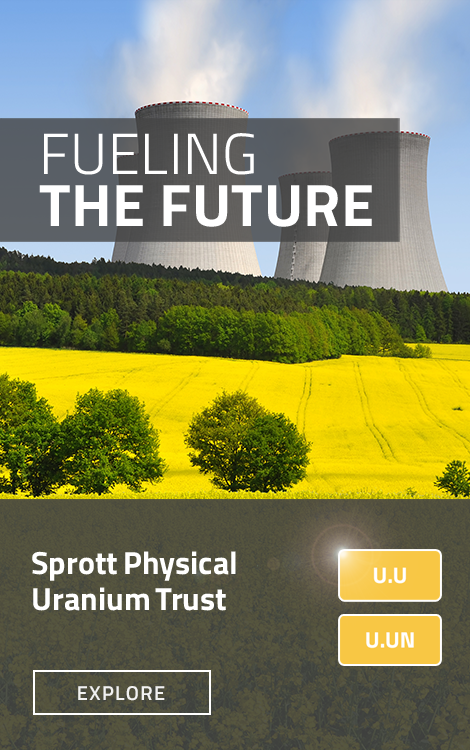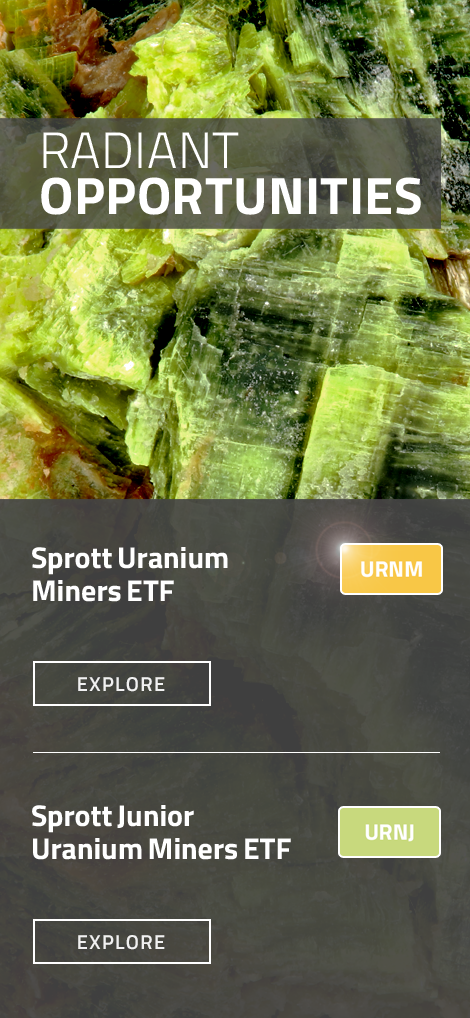In this episode of Shifting Energy (Season 2), John Ciampaglia discusses the major policy shift under President Trump’s new executive orders, which aim to fast-track advanced nuclear technologies and revitalize the entire U.S. nuclear fuel cycle. He explores the implications for uranium prices, mining stocks, small modular reactors and the evolving energy needs of hyperscale AI data centers.
For the latest standardized performance, please visit the individual website pages: URNM and URNJ. Past performance is no guarantee of future results.
Video Transcript
Thalia Hayden: I'm Talia Hayden with the ETFguide. It's nice to see you again. AI is becoming increasingly important for national security, driving an increased demand for electricity. Although the U.S. is already the biggest nuclear power producer, it needs much more. Helping us understand this renewed push to nuclear power and the uranium it runs on is John Ciampaglia at Sprott Asset Management. Welcome, John.
John Ciampaglia: Thanks for having me. Good to see you.
Thalia Hayden: It's great to see you. On May 23, President Trump signed an executive order to rapidly deploy advanced nuclear technologies to support national security objectives, including powering artificial intelligence, computing infrastructure and national security installations. How would that impact uranium supplies, prices and uranium miners?
John Ciampaglia: This has been a long-awaited decree from the Trump administration in terms of their views and policies towards nuclear energy, which the market's been waiting for. We’re very glad to see these executive orders come out. And I think what's most exciting about it is that they built on what the previous administration was trying to do, which was to reinvigorate an industry that had been kind of forgotten about for a long time. And these four orders do that. They take a holistic approach, everything from upstream mining of uranium to fuel processing to building new plants. And obviously, a lot of permitting and regulatory reform needs to happen. It's a holistic approach that should benefit the sector and help the U.S. reestablish its leadership position, which it has held for decades.
Thalia Hayden: Now, we know uranium prices have been under pressure since early 2024, but have started to recover in recent weeks. What should investors make of the recent move higher?
John Ciampaglia: There was a lot of uncertainty and unknowns with respect to how the Trump administration was going to view nuclear energy, and we've always advocated that Republican administrations have been historically very pro-nuclear. And that has been confirmed in that period of uncertainty, and many of the tariffs, and whatnot, really weighed on the uranium price because people just weren't sure how things would go. And we had a meaningful correction late last year. That is starting to unwind. We've seen much stronger uranium prices. I think the demand signal that we will be getting from these future builds will clearly help the uranium price in the uranium sector. And we've seen the price of uranium, which bottomed at $63 a pound several weeks ago. Now we're at $72 a pound. And we think the price has much more momentum to the upside, based on this shift in sentiment we're seeing right now.
Thalia Hayden: It certainly makes sense. Geopolitical tensions have been running high in recent months. How has that impacted uranium markets?
John Ciampaglia: I think it's fair to say that all commodity markets have been impacted in one way or another by shifting geopolitical tensions, trade wars and tariffs, which have been on and off again. Compared to other commodities, uranium has done quite well because it is largely exempt from tariffs. And that's because the U.S. depends on other countries for this critical material. The U.S. is a very small producer of uranium, but it is still the largest consumer of uranium in the world. This mismatch is not surprising to us, as tariffs are not applicable. So it is, I think, a very good signal to utilities. They don't have to be concerned about buying fuel and whether it will be hit with these tariffs. That should help utilities come back to the market and start buying uranium again.
Thalia Hayden: All right, John, let's switch gears slightly. A lot of attention is being paid to small modular reactors. Are they for real, and what is their significance to the continued growth in the nuclear industry?
John Ciampaglia: Small modular reactors are an evolving technology. They're often referred to as the fourth generation design. And they are for real. They're still in the early stage of their regulatory approval and commercialization. But we are starting to get meaningful announcements from some governments. Where I live in Canada, we are building three of these. In Tennessee, the Tennessee Valley Authority has just approved the construction of its very first. And you're starting to see very meaningful announcements made by hyperscalers, which are, you know, the likes of Microsoft and Google and whatnot, that view this technology as part of their energy solution to power these very energy-intensive AI data centers. And several different partnerships and announcements have been made in the last six months that will help bring these new designs to market. One important part of the executive order is streamlining the regulatory process, making it less time-intensive and costly to bring these new designs to market. And that's very important when you're trying to get new technologies to market. And the U.S. clearly wants to be a leader here. It's kind of wide open. There is no leading country here. And the U.S. has rightly determined that it needs to make these investments and incentivize the construction of these plants to be a leader in AI, which a lot of the application is targeted towards.
Thalia Hayden: Final question before we go, what should investors in uranium and uranium miners pay attention to as we move through the rest of 2025?
John Ciampaglia: There are a few things that we're watching very closely. For one, is the spot price recovering? It has recovered almost $10 a pound. So that is moving in the right direction. The second thing is that utilities contract to buy more uranium for future deliveries. There was a period of uncertainty when they stepped to the sidelines. And now you've got this pent-up demand that they need to cover. We hope that utilities get back to buying more uranium. And then there's one more short-term dynamic I'm going to mention: shorting the sector. That basically means that some institutions and hedge funds have been taking bets against the sector, thinking it would fall. And for a period of time, they were right. But we've seen a very sharp V-shaped recovery in the last couple of weeks. And we think there's an opportunity here for a short squeeze, meaning these short sellers need to buy stock to cover their exposures. We're starting to see that. Some of these stocks have gone up 40, 50, 70, and 80% in the last few weeks, and some of this short interest has started to be alleviated. So that's another dynamic that we're watching right now, specifically with the uranium mining stocks.
Thalia Hayden: John, thank you so much. We learned a lot. It was great to see you, and we really appreciate those timely insights.
Important Disclosures
An investor should consider the investment objectives, risks, charges and expenses of each fund carefully before investing. To obtain a fund’s Prospectus, which contains this and other information, contact your financial professional, call 1.888.622.1813 or visit SprottETFs.com. Read the Prospectus carefully before investing.
Exchange Traded Funds (ETFs) are considered to have continuous liquidity because they allow for an individual to trade throughout the day, which may indicate higher transaction costs and result in higher taxes when fund shares are held in a taxable account.
The funds are non-diversified and can invest a greater portion of assets in securities of individual issuers, particularly those in the natural resources and/or precious metals industry, which may experience greater price volatility. Relative to other sectors, natural resources and precious metals investments have higher headline risk and are more sensitive to changes in economic data, political or regulatory events, and underlying commodity price fluctuations. Risks related to extraction, storage and liquidity should also be considered.
Shares are not individually redeemable. Investors buy and sell shares of the funds on a secondary market. Only “authorized participants” may trade directly with the fund, typically in blocks of 10,000 shares.
The Sprott Active Metals & Miners ETF, Sprott Active Gold & Silver Miners ETF and the Sprott Silver Miners & Physical Silver ETF are new and have limited operating history.
Sprott Asset Management USA, Inc. is the Investment Adviser to the Sprott ETFs. ALPS Distributors, Inc. is the Distributor for the Sprott ETFs and is a registered broker-dealer and FINRA Member. ALPS Distributors, Inc. is not affiliated with Sprott Asset Management USA, Inc.



